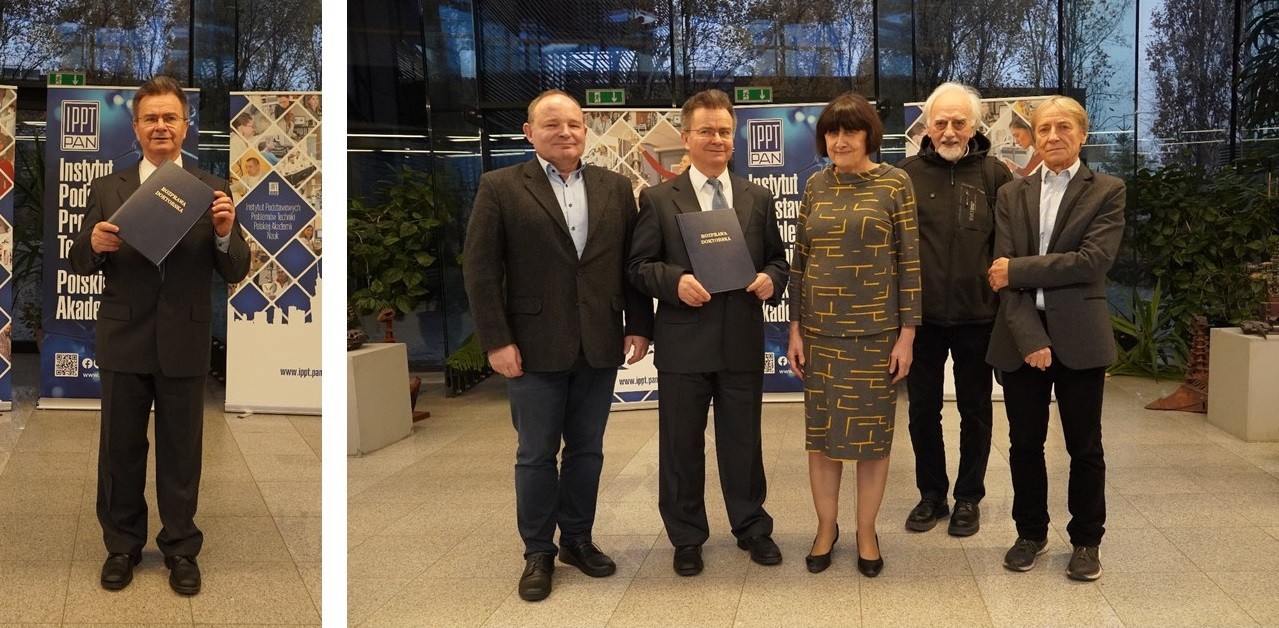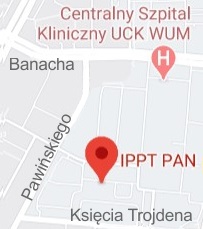Sławomir Białecki from IPPT PAN was awarded the degree of Doctor of Science in the field of Engineering and Technical Sciences in the discipline of Mechanical Engineering.

The presented dissertation is based on six papers [1], [2], [3], [4], [5], [6], which were published between 2014 and 2020.
The aim of these articles was to investigate mathematical representation of certain biological phenomena as quasi-oscillatory processes or traveling wave propagation. The basic mathematical tools in the description of the analyzed phenomena are systems of partial differential equations or single one, the so-called reaction-diffusion equations.
Oscillatory phenomena were analysed by considering the example of spatio-temporal evolution of calcium ion concentration occurring inside eukaryotic cells. These phenomena are related to the time dependent exchange of calcium ions between different cellular compartments. They were considered in the article [1]. Their analysis was based on numerical simulations within the spatially extended model proposed by us, constructed on the basis of the whole-compartment model described by the system of ordinary differential equations originally introduced in [Marhl, M. et al. Complex calcium oscillations and the role of mitochondria and cytosolic proteins. Biosystems 57, 75–86 (2000)]. The Marhl’s model deals with the simulation of calcium concentration oscillations averaged over individual compartments of an eukaryotic cell.
In the spatial model, the evolution of the calcium concentration at a point depends on its position in the compartment. However, for large values of the diffusion coefficients, the time courses of calcium concentration in different points of the compartment cease to differ from each other and become similar to the corresponding courses in the whole-compartment model. In turn, for decreasing values of diffusion coefficients, the waveforms of oscillations become more and more chaotic, and finally they disappear completely for a sufficiently small diffusion coefficient.
The partial differential equations describing the above-mentioned buffered calcium systems are examples of reaction-diffusion equations, which are one of the main tools of mathematical biology. Traveling waves [Volpert, A. I., Volpert, V. A. & Volpert, V. A. Traveling Wave Solutions of Parabolic Systems (American Mathematical Society, 1994)] are one of the basic classes of solutions for such systems. They are important because they can describe the propagation processes of biological signals. Most often, such phenomena are approximately modeled by a quasi-one-dimensional description corresponding to plane waves. This assumption reduces many of the technical difficulties associated with the mathematical analysis of these processes. However, this approximation is often too simplistic, as in the case of processes occurring on curved surfaces, e.g. on the cell membrane, as were analysed in the papers [2], [3], [5]. In these papers, the transduction of biological signals was considered as the propagation of a traveling wave along the surface of the cell membrane. Such a wave can cause cell activation or deactivation. Examples of such phenomena are, in particular, the processes of activation of immune cells (type B lymphocytes) taking place on their membranes, considered in the mentioned above papers and the references therein. Using a simplified model described by a scalar reaction-diffusion equation with a piecewise linear source term in the McKean form, we were able to characterize the activation processes on the cell membrane described (after appropriate scaling) by a two-dimensional unit sphere.
In the work [2], an unstable stationary solution of the above equation was found having the property of separatrix between the two sets of initial conditions that propagate either to a homogeneous active or inactive state on the cell membrane. The obtained result is, in my opinion, very interesting from a mathematical point of view, because the separatrix was found in an analytic form. It is also interesting from a practical point of view, because it allows to determine the existence of a minimum area of initial stimulation ensuring the activation of the whole cell.
In the paper [3] we analyze a time-dependent equation whose stationary counterpart was analyzed in the paper [2]. It contains a technical preparation for the analysis of the existence and properties of the “mild solutions” to this equation, which is the subject of the third article [5]. In the work [3], assuming the existence of weak solutions, we show, among other things, that a solution belonging to the class([0, T], ((0, π))) also belongs to the class ([0, π] × [0, T]), for β ∈ (0, 1/4), i.e. is smooth in terms of the space coordinate and Hölder continuous in terms of the time variable with the exponent β in the interval (0, 1/4).
In the article [5] we continue the study of the phenomenon of wave propagation on a sphere for the aforementioned biological cell activation model. First, we show the existence and unambiguity of “mild solutions” for the linear parabolic initial-boundary value problem with an appropriately given source function f(x, t), assuming that the solutions are given by expansion into a series of Legendre polynomials. To characterize the smoothness of the solutions, we find uniform estimates for the coefficients of this expansion with respect to the spatial variable x. A significant difficulty in this analysis is the x-discontinuity of the source expression implied by the properties of the McKean function in the original version of the equation and making it impossible to use standard theorems to deduce the existence, uniqueness, and regularity of solutions. This proof in general in the nonlinear case is then obtained using the modified method of successive approximations and the existence of solutions for the linear case. The constructed solutions are of class everywhere except the point corresponding to the discontinuity of the source term. We then construct a pair of time-dependent
super- and sub-solutions that imitate the monotonic profiles of a traveling wave fronts moving along the meridians at a certain speeds. Based on the method of proof constructed there, we demonstrate the existence of a solution, having the character of a traveling wave moving at a speed depending on time and position on the sphere.
This type of analysis allows us to conclude that the initial conditions are well defined and if bigger than the threshold state value, the solution propagates towards a higher homogeneous steady state over time. If, on the other hand, the initial conditions are smaller than the threshold condition, then the solution converges to the zero steady state. The threshold state is given by an unstable stationary solution.
The publications [4] and [6] are devoted to the influence of the surface curvature of the boundary of a 3D region on a wave traveling inside the volume the region or on its surface.
In the work [4], we propose, among other things, a model for the polarization of the 3D channels due to the stopping/pinning of wave fronts running inside the channel near the widening concave parts of its boundary. We want to interpret the emergence of the phenomenon of a stationary and stable traveling wave front as a model mechanism connecting the shape of the boundary of the region with the polarization of its interior. As we have demonstrated numerically, complex polarization configurations can be generated in this way on domains describing a variety of biological objects. The proposed model stands out significantly from other spatial pattern formation mechanisms. In contrast to them, e.g. the mechanism based on Turing bifurcation, it is described by a single equation of reaction-diffusion type.
Moreover, the link between polarization and region geometry makes it an excellent tool for describing polarization-segmentation phenomena during morphogenesis processes in biological organisms. The place where wave front line is pinned, is specified analytically and numerically demonstrated in axially symmetric case.
In the paper [6] we prove that very similar phenomena can characterize the propagation of traveling waves on two-dimensional hypersurfaces. In it, we show that a heteroclinic traveling wave front propagating along a 2D boundary surface of a 3D region of a channel can stop on its concave pieces nearby lines corresponding to a constant geodesic curvature. We can consider this phenomenon as one of the possible mechanisms of hypersurface polarization in processes that can be described by equations of reaction-diffusion type. Moreover, 2D boundary polarization can imply polarization of the whole 3D region. The work is complemented by a theoretical analysis of the stability conditions for such solutions depending on the local geometrical properties of the considered hypersurface.
The theoretical results contained in the papers [4] and [6] assume negligible thickness of the wave front (i.e. a width over which the value of the described magnitude changes effectively between its stationary values), so that (asymptotically) it can be identified with a hypersurface (in the 3D case) or a line (in the case of waves on 2D surfaces). This imposes certain conditions on the parameters and functions in the equation under consideration. In particular, this relates to the smallness of the diffusion coefficient and the form of the source function. However, the numerical simulations presented in this paper prove that the described polarization effects take place over a relatively wide range of parameter values and can be fulfilled in the case of many biological phenomena.
References
1. Calcium Oscillations in a Spatially Extended Three Compartment Cell Model, Białecki S, Kaźmierczak B, Proceedings of the XX National Conference Applications of Mathematics in Biology and Medicine, Łochów, September 23-27,ISBN: 978-83-932893-1-8, pp. 15-20, (2014) https://www.mimuw.edu.pl/~kkzmbm/sprawozdania/sprawozdania/spr20/cale/bialecki.pdf, accessed 10.01.2025.
2. Stationary Waves on the Sphere Białecki S, Kaźmierczak B, Tsai J-C SIAM J. APPL. MATH., 75, 4, 1761-1788 (2015), DOI: 10.1137/140999384
3. Regularity of solutions to a reaction-diffusion equation on the sphere: the Legendre series approach, Białecki S, Kazmierczak , Nowicka D, Tsai J-C, MATHEMATICAL METHODS IN THE APPLIED SCIENCES 40, 14, 5349-5369 (2017), DOI: 10.1002/mma.4390
4. Polarization of concave domains by traveling wave pinning, Białecki S, Kaźmierczak B., Lipniacki T, PLOS ONE 12, 12, e0190372-1-10 (2017), DOI: 10.1371/journal.pone.0190372
5. The propagation phenomenon of solutions of a parabolic problem on the sphere, Kaźmierczak B, Tsai J-C, Białecki S, Mathematical Models and Methods in the Applied Sciences 28, 10, 2001-2067 (2018), DOI: 10.1142/S0218202518500483
6. Traveling and standing fronts on curved surfaces, Białecki S, Nałęcz-Jawecki P, Kaźmierczak B, Lipniacki T, Physica D 401, 132215 (2020), DOI: 10.1016/j.physd.2019.132215















